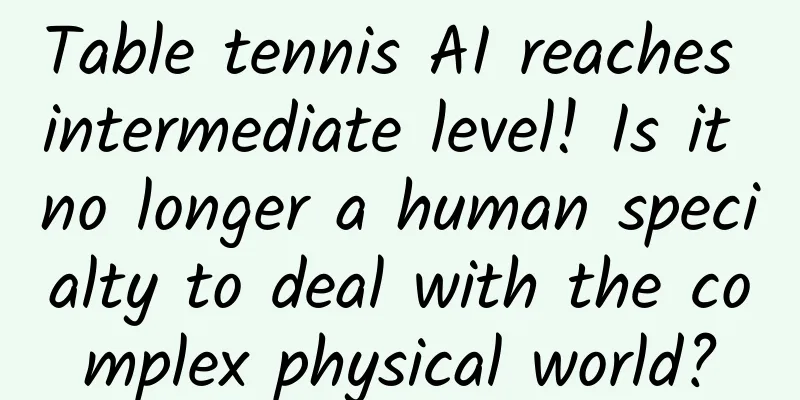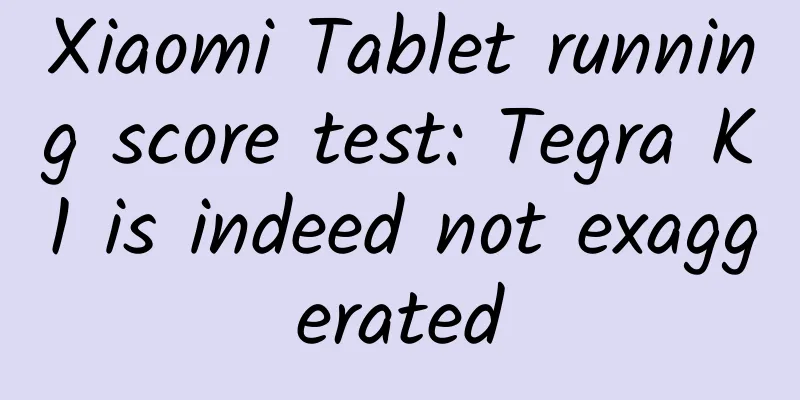Table tennis AI reaches intermediate level! Is it no longer a human specialty to deal with the complex physical world?

|
Table tennis, known as China's "national ball", is a popular ball sport in the world. Playing table tennis well requires quick response, precise control and excellent strategic decision-making. With the development of computer science and technology, research on table tennis robots has become a hot field, but its high speed and precision requirements and target control have become a challenging problem in robotics. Unlike strategy games such as chess and go, it requires robots to have complex human-computer interaction capabilities and complete actions such as sensory detection, trajectory prediction, and motion decision-making within milliseconds. Recently, DeepMind announced that its research and development team has developed a table tennis robot that can reach the level of amateur human table tennis players in competitions, can compete with intermediate players on equal terms, and can even win a considerable proportion of points against advanced players. The most amazing thing is that it has the ability to learn and adapt. In the beginning of the game with humans, it may fall behind, but as the number of games increases, it can simulate and learn the human playing style, adjust its strategy, and make the score closer. Go has been conquered by AI algorithms. How long can humans maintain their advantage in table tennis competitions? Compiled by | Ren After AlphaGo conquered humans in Go, Google DeepMind recently released another big move, this time a robot that can compete with amateur human players in table tennis. It can not only catch the ball with forehand and backhand, but also learn and adapt to the playing styles of different opponents, showing amazing flexibility and learning ability. At present, this table tennis robot has not been named, but technology media Arstechnica suggested calling it AlphaPong. As a sport that requires quick reactions, precise control, and strategic thinking, table tennis has long been considered a huge challenge for AI and robotics. Unlike pure strategy games such as chess and go, table tennis robots require complex human-computer interaction capabilities and need to make decisions and actions within milliseconds. Google DeepMind's latest achievement marks an important step forward in the application of AI in sports competition. The research team proudly declared in the paper: "This is the first robot agent that can compete in sports at the same level as humans, marking an important milestone in robot learning and control technology." How is a table tennis robot trained? The mechanical part of this table tennis robot comes from ABB's IRB 1100 model robot arm. It is one of the most compact and lightweight six-axis robots launched by ABB. It has 6 movable joints and is installed on two linear tracks, allowing it to move freely in the 2D plane and cover most of the table. The end of the robot arm is equipped with a 3D printed racket handle and a standard positive rubber table tennis racket. This setting imitates the horizontal grip of human players, allowing the robot to perform various common table tennis technical movements. The "brain" of the table tennis robot is a complex AI system that is also equipped with a high-speed camera to capture the player's movements and the trajectory of the table tennis ball in real time. A hierarchical and modular strategy architecture is adopted. This architecture mainly consists of two parts: the low-level controller (LLC) and the high-level controller (HLC). LLC is a set of neural networks trained to perform specific table tennis skills, such as forehand and backhand shots, return shots, serve returns, etc. LLC may include hitting a cross-court shot with the forehand, hitting a backhand shot conservatively, and returning a backspin shot with the forehand. LLC also collects and stores detailed skill descriptions to illustrate their performance in different situations, providing important reference for high-level control. LLC uses a convolutional neural network (CNN) architecture that can generate 50Hz joint speed commands directly from visual input to achieve precise motion control. HLC is the commander, coordinating LLCs to make the best strategic decision for each ball based on current game statistics, skill descriptions, and the opponent's abilities. HLC contains several key components, among which the style strategy determines whether to use a forehand or backhand; the rotation classifier identifies the rotation of the ball; the game statistics module tracks the performance of the opponent and the robot; the strategy module uses the first few components as input to give a list of candidate LLCs; and the LLC preference module estimates the performance of each LLC against the current opponent and updates it after each shot to achieve real-time learning and adaptation to the opponent's characteristics. This layered architecture enables the robot to make complex decisions within milliseconds, ensuring both reaction speed and action accuracy. From virtual to real The training process of this table tennis robot system combines the advantages of reinforcement learning and imitation learning, using an innovative iterative approach to overcome the challenges of going from virtual to reality. First, the research team deployed the robot in the real world and collected data on interactions with humans. Through iterative cycles of training on the dataset, evaluating it in the real world, and expanding the dataset with annotated evaluation data, the research team ultimately obtained a large amount of ball status data and serve data. They then used reinforcement learning algorithms to train the AI system in a carefully designed simulation environment that used the MuJoCo physics engine, which allowed them to switch between different racket parameters in the simulation to mimic the effects of topspin and backspin in the real world. After training, the AI system is directly deployed on real robots to compete against human players. The new data generated in this process is used to update the training, forming an iterative cycle: training-deployment-data collection-retraining. In this way, the robot's skills are constantly improved in the process of combining simulation and reality, and the competition becomes gradually more complex. A key advantage of this iterative approach is that the robot is able to discover deficiencies in its capabilities during actual combat and then compensate for these deficiencies through continuous training in a simulated environment. It is this ability to self-improve that allows it to continuously adapt to new opponents and playing styles. Actual performance To evaluate the actual performance of the robot, the research team conducted a comprehensive user study. They first conducted a pre-study in which a professional table tennis coach assessed the level of 59 volunteers, who were divided into four levels: beginner, intermediate, advanced, and advanced+. In the formal user study, 29 participants played three matches against the robot, with an optional free practice session. The main metric of the study was the robot's scores in matches against human players, and the researchers also analyzed the game videos. The results were impressive: The robot won 45% of all matches, 46% of all rounds, and scored 49% of all points. When playing against beginners, the robot has a 100% win rate. Against intermediate players, the robot won 55% of its matches and 50% of its rounds. Against Advanced and Advanced+ players, the robot did not win any games or innings, but still scored 34% of the points. These data show that the overall performance of the robot has reached the level of amateur players, and it is able to compete on equal terms with intermediate players and even win a considerable proportion of points against advanced players. One of the most amazing features of the robot is its ability to adapt in real time. The researchers observed that in the early stages of a match, the robot might fall behind, but as the match progressed, it could quickly adapt to the opponent's play and adjust its strategy to make the score closer. Feedback from participants was also very positive. Players of all skill levels found the matches against the bots to be fun and expressed interest in playing against them again. In post-match interviews, players used words like “fun” and “exciting” to describe the bots. It is worth noting that players of different skill levels have slightly different opinions about the bot. Beginner and intermediate players find the bot more challenging, while advanced and advanced+ players find it more engaging and fun. This suggests that the bot can adapt to opponents of different levels, providing the right amount of challenge and fun for all types of players. This is also what the researchers are particularly interested in. This pleasant interactive experience highlights the potential of AI in sports training and entertainment. Imagine a tireless training partner who can adapt to your level, challenge your limits, and make you have fun. Such an AI sparring partner may completely change the way we learn and practice sports. Limitations and Challenges Despite its overall impressive performance, the robot still has some limitations. The first is that it cannot serve yet and can only rely on humans to serve. Secondly, the research team found that it performs poorly in handling extremely fast balls, extremely low balls and high balls, and it is difficult to accurately judge balls with strong rotation. In addition, its backhand technique still has a lot of room for improvement compared to its forehand. A particularly prominent weakness is the ability to handle backspin balls. When facing backspin balls, the robot's rate of hitting the ball on the table drops significantly. The researchers explained that this is mainly because it is difficult for the robot to make precise control when handling a ball with a low arc and close to the table to avoid hitting the table. At the same time, there are technical limitations in determining the ball's rotation type in real time. These challenges point to directions for future research, such as reducing latency through more advanced control algorithms and hardware optimization, developing more sophisticated collision detection and avoidance algorithms to deal with low balls, exploring stronger strategy-making capabilities, and even allowing robots to play against each other. It can be said that DeepMind's latest achievements demonstrate the great potential of AI and robotics in complex physical world tasks. The application of this technology will go far beyond table tennis. It can be extended to various robotic tasks that require rapid response and adaptation to unpredictable human behavior, achieving a higher level of human-machine collaboration. A researcher in the field of artificial intelligence and large models told Fanpu that AlphaPong can currently meet the needs of most table tennis enthusiasts for sparring. In the long run, it needs to collect more data, including various human skill data such as spin shots and feints, and then use AI's powerful algorithms to defeat humans, but how much it can "see" is unknown. In the later stage, AlphaPong may face the problem of optimizing the existing model under different conditions. Imagine that every athlete can have an AI training partner that can mimic the style of the world's top players while adjusting the difficulty according to their personal characteristics. This will not only improve training efficiency, but also help athletes better understand and improve their own techniques. As technology continues to advance, we can expect to see more similar AI systems emerge in various fields. They are not here to replace humans, but to assist, inspire and challenge us, pushing us to explore the limits of human potential. Special Tips 1. Go to the "Featured Column" at the bottom of the menu of the "Fanpu" WeChat public account to read a series of popular science articles on different topics. 2. Fanpu provides a function to search articles by month. Follow the official account and reply with the four-digit year + month, such as "1903", to get the article index for March 2019, and so on. Copyright statement: Personal forwarding is welcome. Any form of media or organization is not allowed to reprint or excerpt without authorization. For reprint authorization, please contact the backstage of the "Fanpu" WeChat public account. |
Recommend
It’s only the 28th, how come it’s already the end of the month?
Those who were born on February 29th must have ha...
It's not your fault if you can't say the words! Learn more about the "tip of the tongue phenomenon"
...
Hahahaha! Why does your expression look so ugly when you're asleep?
Everyone must have had ugly photos of themselves ...
Cook rarely speaks out: Virtual reality is quite interesting and will become mainstream in the future
According to the technology website TechRadar, to...
Energy efficiency leader opens a new era. See how Samsung uses hard power to tell the truth
Smart home appliances were once considered a gimm...
Let’s celebrate the birthday of “π” together on March 14! How much do you know about pi?
Today is International Pi Day, and also Internati...
Is the moon actually black?
Lunar soil refers to the soil unique to the moon....
Lenovo YOGA2 Review
Lenovo YOGA 2 13 can be regarded as a popular vers...
The world's first mass-produced solar car has turned yellow? Maybe it never existed...
The world's first solar car went bankrupt jus...
Can’t write good copy? That’s because user needs are not grasped! !
What do we think about when we think about writin...
What knowledge is needed to operate Tik Tok?
Douyin in the south and Kuaishou in the north are...
Do you still remember the Ouija board game you played back then? Would you still be afraid if you tried it now?
Unconsciously, the popularity of the Pen Fairy Ou...
"Chang'e Stone"! Chinese scientists discovered a new mineral on the moon for the first time!
On September 9, the eve of the traditional Chines...
Lowering the threshold! How big a trend will AI-customized proteins bring?
The following article is from Nature Portfolio, a...
Isn’t it really a waste of money to spend so much money on protecting wildlife?
Protecting wildlife can help the Earth have a hig...









